|
Was a good show up here in CNY
|
|
|
|
|
Originally Posted By SparticleBrane: I could see it in NC! I stayed up pretty late tonight to watch the meteors and hopefully get some photos of them, and had no idea this was happening. Got an unexpected aurora light show for about 20 minutes from about 0210 to 0230. Will post photos later. Going to bed for now.  View Quote What part of NC? I’ve been up since 0300, nice and clear, but no auroras here in East TN. |
|
|
|
|
And we're back to G3/KP7 again. Getting an assist from a CH/HSS too but I'm guessing we're in the flux rope of the X1.3 CME and maybe getting an arrival of one of the subsequent CMEs mixed in.
I was up until 2:30 this morning watching the show then had to get up for work at 6:30, lol. Worth it. More pics: |
|
|
The road to Hell is paved with presidential candidates.
|
|
Originally Posted By cgrant26: And we're back to G3/KP7 again. Getting an assist from a CH/HSS too but I'm guessing we're in the flux rope of the X1.3 CME and maybe getting an arrival of one of the subsequent CMEs mixed in. I was up until 2:30 this morning watching the show then had to get up for work at 6:30, lol. Worth it. More pics: https://www.ar15.com/media/mediaFiles/203945/signal-2024-08-12-071514_010_jpeg-3292555.JPG https://www.ar15.com/media/mediaFiles/203945/signal-2024-08-12-071514_009_jpeg-3292556.JPG https://www.ar15.com/media/mediaFiles/203945/signal-2024-08-12-071514_008_jpeg-3292557.JPG https://www.ar15.com/media/mediaFiles/203945/signal-2024-08-12-071514_007_jpeg-3292558.JPG https://www.ar15.com/media/mediaFiles/203945/signal-2024-08-12-071514_006_jpeg-3292560.JPG View Quote I am curious how similar your pictures are to what you could see with just your eyes. I took a pic last night with just a phone camera but it was much more colorful than what I could see with the naked eye, which was more or less a faint red glow. |
|
|
|
|
Originally Posted By ED_P: I am curious how similar your pictures are to what you could see with just your eyes. I took a pic last night with just a phone camera but it was much more colorful than what I could see with the naked eye, which was more or less a faint red glow. View Quote The camera definitely sees more than the naked eyes. I actually looked for a filter setting to get closer to human eye representation but there's nothing in between. It either doesn't pick it up or night mode amps the brightness. It's still pretty evident with naked eye though that the colors are there save for maybe some of the deeper reds. Also, tha camera doesn't capture the fast "shock wave rippling" and "slow dance" effects and unfortunately night mode on this device doesn't work for video like it does for stills. |
|
|
The road to Hell is paved with presidential candidates.
|
|
Spectacular pics. Thank you for sharing them.
|
|
|
|
|
Somewhere godforsaken where the Pacific and Bering Sea meet. With NODS I was able to see the lights waving as they hit the atmosphere. It was pretty cool. I've got video of it but am unable to link it on here. Also got some of the meteor shower at the same time.
|
|
|
|
|
Spotted them around midnight last night. Was out looking for Perseids and thought it looked odd. Whipped out the camera and sure enough. Friends in Southern WI could see it. On a phone camera, video is far more representative than night-mode pictures. Just faint lighter streaks. Woke my kids up to look and they had a hard time seeing what I was showing them. Everyone (myself included) assumes that it'll look like the pictures. Does it actually look like that to the naked eye anywhere?
|
|
|
|
|
https://spaceweather.com/
GEOMAGNETIC STORMS ARE UNDERWAY: Earth is experiencing G2-class geomagnetic storms on Aug. 12th as we move through the wake of a CME that struck over the weekend. If NOAA models are correct, two more CMEs could arrive before the day is over, extending the storm and possibly boosting it to category G3. Aurora alerts: SMS Text AURORAS IN THE USA: As predicted, a CME hit Earth on Aug. 10th. The impact was weak; at first it did not cause a geomagnetic storm. However, as Earth moved deeper into the CME's magnetized wake, a G1-class storm began, and auroras spread into the United States as far south as Oregon. Quinn Nykiel photographed the display with Mt Hood in the background: 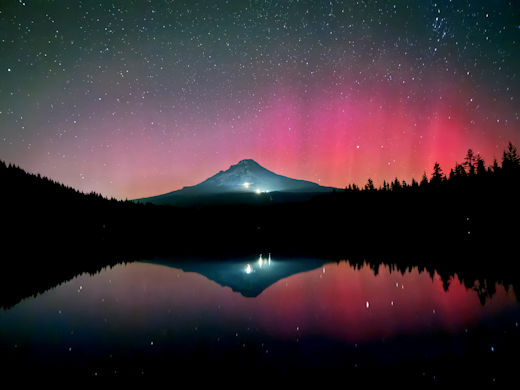
|
|
|
|
|
https://earthsky.org/sun/sun-news-activity-solar-flare-cme-aurora-updates/
Sun news August 12: Geomagnetic storms bring auroras Today’s top story: Overnight last night brought an explosion of geomagnetic storms and auroras. Earth’s magnetic field was excited up to G3 (strong) levels with the arrival of several coronal mass ejections (CMEs) from August 7-8 and possibly August 10. There could be more activity to come over today (August 12) into tonight. At the time of this post, the geomagnetic field is storming at the G2 (moderate) level. Watchers may get the excitement of both auroral displays and the Perseid meteor display. Some lucky people already have. Good luck tonight, skywatchers! Last 24 hours: Sun activity is moderate with two M flares during our observation period between 11 UTC yesterday and 11 UTC today. The total flare production was 13, two M, and 11 C flares. The largest event was an M1.7 at 20:18 UTC on August 11 from AR3777. It caused an R1 (minor) radio blackout that affected an area over the Pacific Ocean and the western Americas. The list of M flares for the period: • M1.7 at 20:18 UTC on August 11 from AR3777. R1 (minor) radio blackout over the Pacific Ocean and the western Americas. • M1.3 at 23:58 UTC on August 11 from AR3780. R1 (minor) radio blackout over the Pacific Ocean. Active region AR3777 produced six flares including one of the M flares. The sun has 11 sunspot regions. Most of the regions on the disk are stable or in decay. AR3780 retained its delta region with a beta-gamma-delta magnetic complexity. The region remains the largest in size. Several new regions were numbered, AR3785, AR3786, AR3787, and AR3788. Next 24 hours: The chance for C flares is 99%. The chance for M flares is 75%. The chance for X flares is 30%. Next expected CME: No additional Earth-directed coronal mass ejections (CMEs) were observed in the available coronal imagery. Current geomagnetic activity: Earth’s magnetic field is experiencing a G2 geomagnetic storm at the time of this writing (11 UTC on August 12). Periods of G1 to G2 (minor to moderate) geomagnetic storms are likely today due to the arrival of one or more coronal mass ejections (CMEs) that left the sun August 7-8 and August 10. Quiet to active levels are expected on August 13-14 as the CMEs’ influence wanes. |
|
|
|
|
Originally Posted By Stonia: ... Does it actually look like that to the naked eye anywhere? https://www.ar15.com/media/mediaFiles/203509/1000009113_jpg-3292589.JPG https://www.ar15.com/media/mediaFiles/203509/1000009111_jpg-3292592.JPG View Quote Back in October of 2003 they were very visible to the naked eye in Massachusetts. I remember a bright red column extending up almost directly overhead for about an hour. In previous years I'd seen the green moving curtain variety in Mass as well. I missed the big event earlier this year so can't comment on what that looked like to the naked eye at my latitude. |
|
|
|
|
Originally Posted By Stonia: Spotted them around midnight last night. Was out looking for Perseids and thought it looked odd. Whipped out the camera and sure enough. Friends in Southern WI could see it. On a phone camera, video is far more representative than night-mode pictures. Just faint lighter streaks. Woke my kids up to look and they had a hard time seeing what I was showing them. Everyone (myself included) assumes that it'll look like the pictures. Does it actually look like that to the naked eye anywhere? https://www.ar15.com/media/mediaFiles/203509/1000009113_jpg-3292589.JPG https://www.ar15.com/media/mediaFiles/203509/1000009111_jpg-3292592.JPG View Quote The storm that happened earlier in the year was strong enough to see the colors vividly even in SE Wisconsin, unfortunately a thunder storm passing through did prohibit the best views. I've seen them a few times up in Canada, but that was well before cell phones and taking clear photos were a thing. |
|
|
|
|
Well I guess I should have been checking this thread yesterday. The purple tint to the sky low in the horizon was the aurora. I was here in town, so I just thought there were some new lights in town throwing off some purple light polution. How embarrassing. At least I saw a bunch of shooting stars.
|
|
|
|
|
|
|
|
|
|
August 12, 2024 @ 11:40 UTC (UPDATED)
Moderate (G2) to Strong (G3) storm conditions continue as the Bz/IMF component of the solar wind has been stuck in a south pointing position for several hours. This is likely the result of a number of coronal mass ejections passing near or past Earth. Reports of visible aurora appear to be fairly widespread across northern Europe and parts of North America. A strong (G3) storm watch remains in effect until 15:00 UTC (Aug 12). Further updates will be provided as the day progresses in regards to the latest geomagnetic conditions. UPDATE: The Severe (G4) geomagentic storm threshold was reached at 14:42 UTC (Aug 12). Aurora sky watchers across Europe should be alert once dark outside. Sky watchers across North America should stay tuned. ALERT: Geomagnetic K-index of 8, 9- Threshold Reached: 2024 Aug 12 1442 UTC Synoptic Period: 1200-1500 UTC Active Warning: Yes NOAA Scale: G4 - Severe |
|
|
|
|
https://spaceweather.com/
SEVERE GEOMAGNETIC STORM--NOW! Today's strong G3-class geomagnetic storm has just intensified to category G4 (Severe). This means mid- to low-latitude auroras may be visible from any dark location on Earth. Aurora alerts: SMS Text The ongoing storm is in response to multiple CME impacts on Aug, 10th, 11th and 12th. Last night, auroras were spotted in more than 30 US states as far south as Texas, Mississippi, Colorado and California. "Pulsating auroras hung over our heads for more than an hour," reports Elżbieta Haftek, who sends this picture from Eden Prairie, Minnesota: 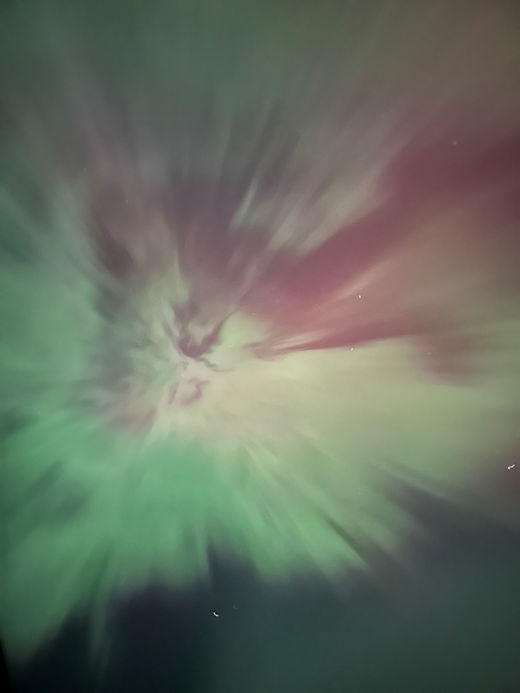
|
|
|
|
|
|
|
|
|
|
|
|
|
"GD: serious answers to ridiculous questions and ridiculous answers to serious questions" --Naamah
|
|
Fuckin cloudy here.
|
|
|
|
|
I forgot this was happening. I was out late near Lake Erie, and was poking around to see if I could catch any of the meteor shower. Couldn't see shit but I thought I caught a faint bit of the aurora. Found a darker spot and confirmed it.
|
|
|
|
|
https://spaceweather.com/
GEOMAGNETIC STORM WATCH STILL IN EFFECT: Yesterday's severe (G4-class) geomagnetic storm is over. However, the watch is still in effect. NOAA forecasters believe that moderate (G2-class) storms could occur on Aug. 13th as Earth exits the combined wake of the CMEs that sparked yesterday's storm. Geomagnetic storm alerts: SMS Text SEVERE STEVE: The severe geomagnetic storm of Aug. 12th sparked widespread auroras in both hemispheres, with sightings in the USA as far south as Texas, Mississippi and Arizona. Upon closer inspection, not all the lights were auroras. Many observers saw STEVE: 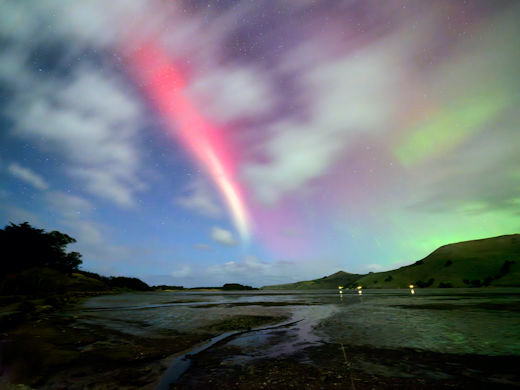 "Here in New Zealand we had a front row seat for an exciting display of Southern Lights," reports photographer Ian Griffin from a remote area of the Otago Peninsula. "The auroras were topped off by one of the best displays of STEVE I have ever seen." STEVE (Strong Thermal Emission Velocity Enhancement) is the pink ribbon of light in Griffin's photo. It looks like an aurora, but it is not. The pink glow is caused by hot (3000°C) ribbons of gas flowing through Earth’s magnetosphere faster than 13,000 mph. Strong geomagnetic storms do a good job of setting these ribbons in motion. Sky watchers have been watching STEVE for centuries not realizing what it was. Only recently have researchers started studying it as a phenomenon distinct from auroras. There is still much to learn, so submit your sightings here. more images: from Andrew Harvey of Zigzag, Oregon; from Anthony Kroes of Pulaski, Wisconsin |
|
|
|
|
https://earthsky.org/sun/sun-news-activity-solar-flare-cme-aurora-updates/
Sun news August 13: Severe geomagnetic storming, auroras … and Perseids! Today’s top story: The geomagnetic storm level went up to G4 (severe) late yesterday (August 12), and more are anticipated today. We hit G4 at about the 12 to 15 UTC time period on August 12. Geomagnetic storming stayed at G2-G3 (moderate-strong) levels during most of the past day (11 UTC yesterday to 11 UTC today). And so conditions have been ripe for auroras at northerly latitudes, and as far south as the U.S. states of Iowa, Oregon and California! Along with the auroras for many lucky observers, there were also meteors! The Perseid meteor shower had its peak mornings yesterday and today (August 12 and 13). These two events combined to form an outstanding show. Did you see them? Share your beautiful photos with the EarthSky community! More G1 (minor) geomagnetic storming is expected during the rest of the day today. That means there’ll be chances for more auroras tonight. Last 24 hours: Solar activity is still at moderate levels thanks to an isolated M flare during our observation period between 11 UTC yesterday and 11 UTC today. Flaring production dropped down in the past day to only nine flares, an M and eight C flares. The largest event was an M1.2 at 22:57 UTC on August 12 from AR3784. It caused an R1 (minor) radio blackout that affected an area over the Pacific Ocean west of Hawaii. Active region AR3784 produced four flares including the M flare to become the lead flare producer of the day. The sun has 10 sunspot regions. Most of the regions on the disk are stable or in decay. There are two active regions showing a beta-gamma-delta magnetic complexity, they are AR3780 and AR3784. These represent promises for more M flares and even an X flares may occur. AR3777 shows a beta-gamma configuration while the rest of the regions show an alpha or beta and remain stable or in decay. While AR3780 keeps a large size in extension, now AR3784 is growing now showing as the largest in size. Look for it in the northeast quadrant. A large coronal hole emerged on the north solar hemisphere close to solar north pole. Next 24 hours: The chance for C flares is 99%. The chance for M flares is 75%. The chance for X flares is 30%. Next expected CME: No Earth-directed coronal mass ejections (CMEs) were observed in the available coronagraph imagery. Current geomagnetic activity: Earth’s magnetic field is quiet at the time of this writing (11 UTC on August 13). But, from about 12 to 15 UTC yesterday, we saw a severe G4 geomagnetic storming. And geomagnetic storming remained at the G2 to G3 (moderate to strong) level throughout late yesterday early today (August 13). More G1 (minor) levels are expected during the rest of the day today. Tomorrow (August 14), the effects of the CME are expected to wane, and storm levels and subsequent auroral displays are expected to do likewise. |
|
|
|
|
3784 Just popped off an X1.1
Seeing some early dimming so definitely a CME release but it's still early. C2/C3 will tell a better story.  AR3784 is front and center so any CME would likely be an Earth-directed bulk hit. |
|
|
The road to Hell is paved with presidential candidates.
|
|
Originally Posted By cgrant26: 3784 Just popped off an X1.1 Seeing some early dimming so definitely a CME release but it's still early. C2/C3 will tell a better story. https://swl-ips.s3.eu-west-2.amazonaws.com/monthly_2024_08/ezgif-7-d0674e076d.gif.2413d427978f1e2f46043cf018178e1d.gif AR3784 is front and center so any CME would likely be an Earth-directed bulk hit. https://www.ar15.com/media/mediaFiles/203945/SDO_HMIIF_512_jpg-3294007.JPG View Quote Nice. Was reading this an hour ago. |
|
|
|
|
https://earthsky.org/sun/sun-news-activity-solar-flare-cme-aurora-updates/
Sun news August 14: Surprise! X1.1 flare Today’s top story: BAM! The sun surprised us with an X1.1 flare earlier today (6:45 UTC on August 14). The producer was active region AR3784. The blast provoked an R3 (strong) radio blackout over northeast India. This active region AR3784 is the largest in extension on the Earth-facing side of the sun now. Besides that, it shows a beta-gamma-delta magnetic complexity, the largest, meaning it has the potential for more Ms and X flares. This sunspot region is also breaking Hale’s Law, which applies to the orientation of the magnetic polarity of sunspots. That is, AR3784 is showing a vertical polarity, while horizontal is the common layout. This different orientation might have created an instability … and the X1.1 flare we just saw today. Stay tuned for more sun news. Last 24 hours: Sun activity is high, due to the X1.1 flare by AR3784 at 6:45 UTC on August 14. Flaring production overall increased from nine flares yesterday up to 18 flares over the past day. The lead flare producer position of the period goes to AR3784, which produced 13 flares, the X1.1 flare, three Ms and nine C flares. The largest flare of the period was the X1.1 flare by AR3784. This is the list of the X and M flares: • M1.0 at 17:29 UTC on August 13 from AR3784. R1 (minor) radio blackout over the Caribbean. • M1.3 at 22:45 UTC on August 13 from AR3777. R1 (minor) radio blackout over Hawaii. • M1.2 at 22:51 UTC on August 13 from AR3784. R1 (minor) radio blackout over Hawaii. • M4.2 at 23:44 UTC on August 13 from AR3784. R1 (minor) radio blackout over the Pacific Ocean off the west of Hawaii. • M4.4 at 4:02 UTC on August 14 from AR3774. R1 (minor) radio blackout over Philippines. • X1.1 at 6:40 UTC on August 14 from AR3784. R3 (strong) radio blackout over northeast India. The largest. The sun has nine sunspot regions on its Earth-facing side. Next 24 hours: The chance for C flares is 99%. The chance for M flares is 75%. The chance for X flares is 25%. Next expected CME: The X1.1 flare produced by active region AR3784 on August 14 is under modeling and analysis to determine if any coronal mass ejections (CMEs) are heading our way at Earth. Other than that, no other CMEs were observed in the available coronagraph imagery. Current geomagnetic activity: Earth’s magnetic field is quiet at the time of this writing (11 UTC on August 14). The new large coronal hole on the north hemisphere we reported yesterday is moving into a geoeffective position to be reached on August 16. That means the fast solar wind it produces will start heading our way at Earth, possibly to produce auroras. For now, quiet levels are anticipated for August 15. |
|
|
|
|
Originally Posted By bkpkr: Nice. Was reading this an hour ago. https://www.ar15.com/media/mediaFiles/125849/IMG_4740_jpeg-3294013.JPG View Quote That spot is developing nicely. Some really impressive deltas in it. Here's a comparison I put together of 3784 and 1520 that caused the July 2012 super storm that missed us by 9 days. The lighter spot in the middle is an artifact of the magnetogram translation software. It happens when the strength gets really high. |
|
|
The road to Hell is paved with presidential candidates.
|
|
I’m late to the party but I caught a few pictures from Michigan. Like others, I was looking for meteors. I was using my iPhone on a tripod.
It was pretty subtle to the naked eye. It reminds me of a high altitude haze until you see it shimmering. I used the iPhone camera to scan the sky around me and spotted the colors. |
|
|
“Once is happenstance. Twice is coincidence. Three times is enemy action.”
|
|
August 14, 2024 @ 06:40 UTC (UPDATED)
A long duration X1.1 solar flare was just observed around AR 3784 peaking at 06:39 UTC (Aug 14). The active region is currently directly facing Earth and this event may be eruptive based on the latest imagery courtesy of SDO/AIA 093a. More details to follow. UPDATE: Coronagraph imagery following the X1 flare is starting to slowly come in and the prospect of a noteworthy CME does not look good. A CME following an earlier M-Flare off the west limb at 04:02 UTC is visible, however only the very faintest of CME is seen emerging after the X1 and it is barely visible, at least in the imagery that is currently available. More updates later today. UPDATE #2: An updated CME tracking model is showing that the CME associated with the X1.1 flare early Wednesday morning will pass Earth.... eventually. The faint, slow moving plasma cloud is predicted to reach our planet by August 18th. A weak impact may generate aurora at higher latitudes, but I do not expect much in the way of a geomagnetic storm. More updates regarding this on the weekend. |
|
|
|
|
https://spaceweather.com/
GEOMAGNETIC STORM WATCH (G1): Yesterday's X1-class solar flare from sunspot AR3784 hurled a faint CME directly toward Earth. A NOAA model predicts it will arrive on Aug. 18th. NASA's model leans more toward Aug. 17th. Either way, the CME's impact could cause a minor G1-class geomagnetic storm. CME impact alerts: SMS Text A BLUE FLASH FROM VENUS: Italian photographer Paolo Palma was watching Venus sink into the sunset on Aug. 12th when something extraordinary happened. A piece of the planet broke away and turned blue: 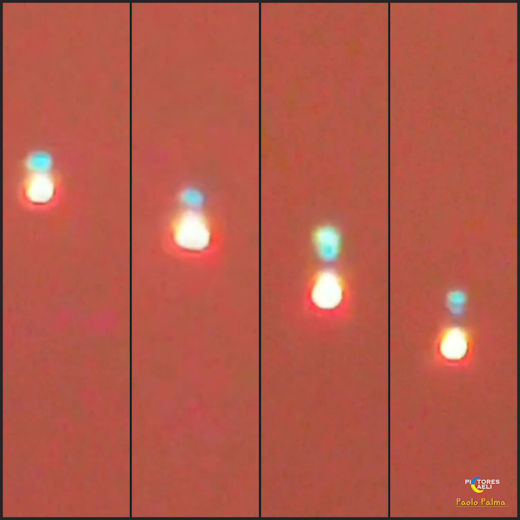 This is a very rare blue flash from Venus. You've heard of green flashes. They're sometimes seen when the sun is setting at sea. Temperature inversions and strong thermal gradients in air above the sea surface split the sun into R-G-B colors and magnify the green into a dramatic flash above the setting sun. Blue flashes are formed in the same way as green flashes. However, blue flashes are harder to see because air molecules and aerosols scatter blue light. When the air is exceptionally clear, however, the blue flash emerges. Photographers are lucky when they catch a blue flash from the sun. Catching one from Venus is a once in a lifetime shot. Congratulations, Paolo! |
|
|
|
|
https://earthsky.org/sun/sun-news-activity-solar-flare-cme-aurora-updates/
Sun news August 15: Sun-stuff from X flare coming our way Today’s top story: A coronal mass ejection (CME) produced during yesterday’s X1.1 flare event is coming directly our way at Earth. Experts are expecting the bulk of the ejecta to arrive on August 18. But, they say, we could also see an early arrival on August 17. The impact of this solar material with Earth’s magnetic field should boost auroral displays. So clean and polish those camera lenses! And please share your photos with the EarthSky community. By the way, did you see the many images of auroras and Perseids from earlier this week? Wow. Last 24 hours: Sun activity is still high. And active region AR3784 – producer of the X flare – is still the biggest region on the Earth-facing side of the sun. And it retains its beta-gamma-delta magnetic complexity, meaning it has the potential for more Ms and X flares. Plus it’s still bearing its Hale’s Law-breaking configuration: AR3784 has a vertical magnetic polarity, in contrast to most sunspots (which have a horizontal layout). There’s a second active region with a beta-gamma-delta configuration still on Earth-facing sun. It’s AR3780, which is about to depart on the sun’s southwest limb (edge). Overall, flare production dropped during the past day (11 UTC yesterday to 11 UTC today), but we did see three M flares, one of them an M5.3. The total for the past day was nine flares (three Ms, six Cs) in contrast to yesterday’s 18. Lead flare producer of the period was AR3784, with four C flares. AR3780 followed closely, with three flares, an M and two Cs. The sun has nine sunspot regions on its Earth-facing side. There is a newcomer on the solar disk now labeled AR3789. Here’s the list of the M flares: • M1.1 at 13:24 UTC on August 14 from incoming region in the southeast as-yet-unnumbered. R1 (minor) radio blackout over the Atlantic Ocean off the west coast of Africa. • M5.3 at 15:49 UTC on August 14 from an incoming region in the southeast as-yet-unnumbered. R2 (moderate) radio blackout in the Caribbean Sea over the British Virgin Islands. The largest. • M1.1 at 3:48 UTC on Augusts 15 from AR3780. R1 (minor) radio blackout over the Philippines. Next 24 hours: The chance for C flares is 99%. The chance for M flares is 75%. The chance for X flares is 25%. Next expected CME: The coronal mass ejections (CMEs) produced during the X1.1 event by active region AR3784 on August 14 is directly heading our way at Earth. Arrival time for the bulk of the material) is estimated to be August 18 (or possibly slightly earlier). No other CMEs Earth-bound were observed in the available coronagraph imagery. Current geomagnetic activity: Earth’s magnetic field is quiet at the time of this writing (11 UTC on August 15). Low levels of geomagnetic activity are expected during the rest of the day today, extended through tomorrow (August 16). That large coronal hole on the sun’s north hemisphere will likely become geoeffective on August 16. That means the fast solar wind it produces will start heading our way at Earth, possibly to produce auroras. The CME associated with the X1.1 flare event is anticipated to arrive on August 18, but there are chances of an early arrival on August 17. Get ready, aurora-watchers. 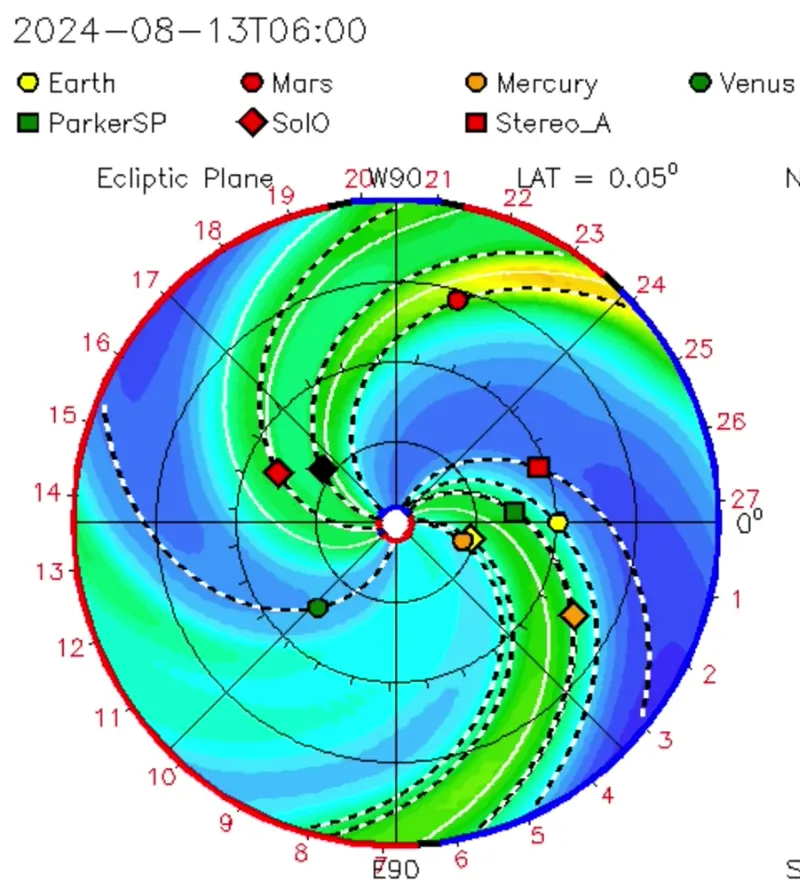 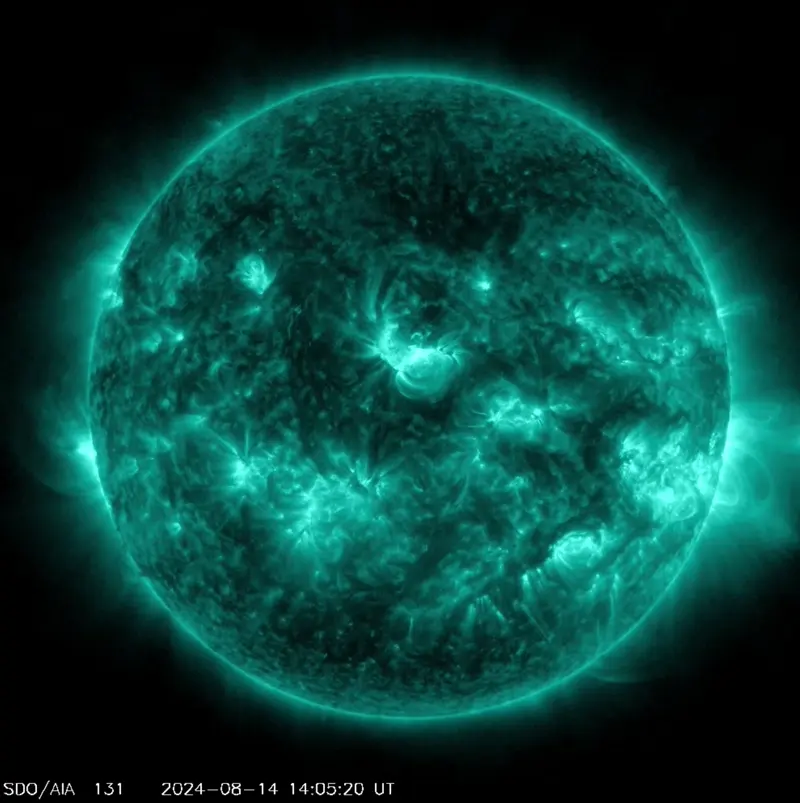
|
|
|
|
|
https://spaceweather.com/
GEOMAGNETIC STORM WATCH (G1): Wednesday's X1-class solar flare from sunspot AR3784 hurled a faint CME directly toward Earth. Minor G1-class geomagnetic storms are possible when it arrives. A NOAA model predicts Aug. 18th; NASA's model leans more toward Aug. 17th. CME impact alerts: SMS Text AURORAS SHOULD NOT BE ORANGE (BUT THEY ARE): During this week's severe (G4-class) geomagnetic storm, Tony Bendele of Pennsylvania saw something rare and a little mysterious. "Orange auroras!" he says. "Yes, Orange. I had never seen this color in auroras before." He took this picture before sunrise on Aug. 12th: 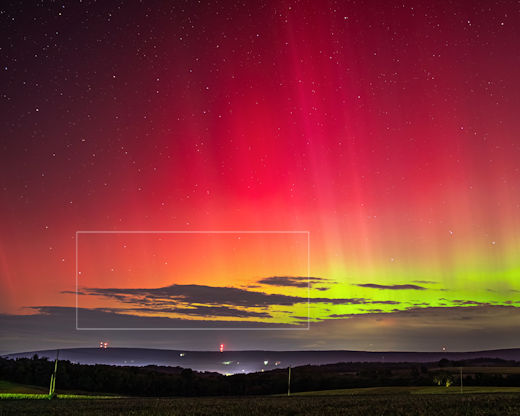 "At first, I thought something was wrong, so I checked this image numerous times. The color orange is really there," he says. What's so mysterious about orange? Auroras get their colors from specific atoms and molecules in Earth’s atmosphere. For instance, green is due to oxygen, while pink comes from nitrogen. The problem is, there’s nothing in the air capable of making bright orange. Theoretically, nitrogen and oxygen (N2, N2+, and O2+) can produce emissions at orange wavelengths. However, these emissions are very weak compared to other competing colors produced by the same molecules. Auroras should not be orange. 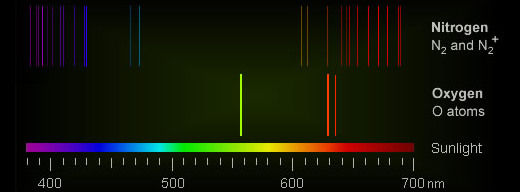 The answer may be simple. During typical geomagnetic storms, red auroras and green auroras are well separated; red on top, green on the bottom. However, when geomagnetic storms become intense, as happened on Aug. 12th, red and green auroras can mix in a zone 150 km to 200 km high. The overlap naturally produces a yellow-orange glow–no mystery molecule required. |
|
|
|
|
https://earthsky.org/sun/sun-news-activity-solar-flare-cme-aurora-updates/
Sun news August 16: Confirmed, sun-stuff from X flare arrives on August 17 Today’s top story: It is now confirmed, sun-stuff in the form of a coronal mass ejection (CME) produced during the X1.1 flare event by active region AR3784 is expected to arrive late August 17 or early August 18at the most. This solar material was hurled into space by our star and sent direct in our direction at Earth. The X1.1 was a rather short duration flare and the blob of magnetic fields and solar particles is expected to disturb Earth’s magnetic field for a G1 (minor) geomagnetic storm. NOAA has issued an alert watch. urning our head back to our star, sun activity returned to low levels with only C flares produced but fiery activity via long lasting prominences dancing all around the solar horizon calls for an active sun. Attracts attention in particular the ones we saw on the east limb (edge) forming gorgeous dancing arcs meaning more activity is just around the corner coming our way. Keep with us for more sun news. Last 24 hours: The sun produced only C flares during the past day for a low level solar activity. 16 Cs was the flaring production of our star in our observation period between 11 UTC yesterday and 11 UTC today. The largest was a C7.8 blasted out by active region AR3786 in the solar southwest. The flare was produced at 17:35 UTC on August 15. Lead flare producer of the period was sunspot region AR3790 who sparked seven C flares. The sun has nine sunspot regions on its Earth-facing side. There is a newcomer on the solar disk now labeled AR3790. Most of sunspot regions on the solar disk appear either stable or in decay with an alpha or beta magnetic configuration. Only AR3784 keeps its beta-gamma-delta magnetic complexity, meaning it has the potential for more Ms and X flares. A new coronal hole emerged in the south hemisphere close to the solar south pole so now we have two large coronal holes sending its fast solar wind to us at Earth. Thee one we have been observing on the north hemisphere is now geoeffective located meaning its fast solar wing is heading our way at Earth. This is a source for us at Earth for more auroral displays. Next 24 hours: The chance for C flares is 99%. The chance for M flares is 70%. The chance for X flares is 20%. Next expected CME: No coronal mass ejections (CMEs) Earth-bound were observed in the available coronagraph imagery. Current geomagnetic activity: Earth’s magnetic field is quiet at the time of this writing (11 UTC on August 16). Quiet to unsettled condition are expected for the rest of the day extended thru tomorrow August 17. A large coronal hole in the north hemisphere reached geoeffective position. A new large coronal holes has joined. The fast solar wind these two guys produce will start coming to us at Earth for more chances of auroras. The CME associated with the X1.1 event arrival is expected late on August 17 but most likely it may occur early on August 18. This will bring conditions for a G1 (minor) geomagnetic storm. Alert for aurora hunters. |
|
|
|
|
So the one coming around is being downgraded?
|
|
|
|
|
|
|
August 17, 2024 @ 14:00 UTC (UPDATED)
What looks to be a shock passage was just detected by the ACE spacecraft. This should be related to the faint halo CME associated with the X1.3 solar flare on August 14th. The solar wind speed increased by around 100 km/s to 430 km/s. The Bz component of the interplanetary magnetic field (IMF) is also pointing south, at least initially. More details to follow. CME Impact: The Boulder magnetometer is showing a CME impact around 14:30 UTC (Aug 17). Enhanced geomagnetic activity (Kp4) will be possible in the hours ahead with a chance for minor (G1) storming at higher latitudes. |
|
|
|
|
https://spaceweather.com/
THE CME HAS ARRIVED: A CME hurled toward Earth by an X1-class solar flare on Aug 14th has arrived. It hit our planet's magnetic field on Aug. 17th around 1400 UT. The relatively weak impact could spark G1-class geomagnetic storms with auroras at hight latitudes. Aurora alerts: SMS Text ROCKET FUEL OVER THE KATTEGAT: Nobody outgasses like SpaceX. The company's latest launch produced a spectacular fuel dump over Denmark around midnight on Aug. 17th. Bettina Begtoft photographed the display over the Kattegat, a body of water connecting the North and Baltic Seas: 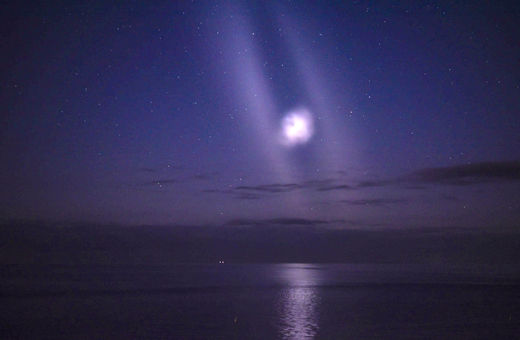 "This is the Space X Transporter-11 mission," says Begtoft. It lifted off from California's Vandenberg Space Force Base on Aug. 16th carrying 116 satellites for a mix of government and commercial customers. All 116 were successfully deployed into Earth orbit less than three hours after launch. Begtoft may have witnessed the beginning of a "SpaceX spiral." On rideshare missions like Transporter-11, the numerous satellites from various clients have different destinations. SpaceX must rotate the second stage of the rocket for deployment. As a result, stage 2 is still rotating when they do the de-orbit burn and this creates a spiral. Here are some examples from New Zealand, east Africa, Hawaii, and, most famous of all, Alaska. More pics at the link above. |
|
|
|
|
https://earthsky.org/sun/sun-news-activity-solar-flare-cme-aurora-updates/
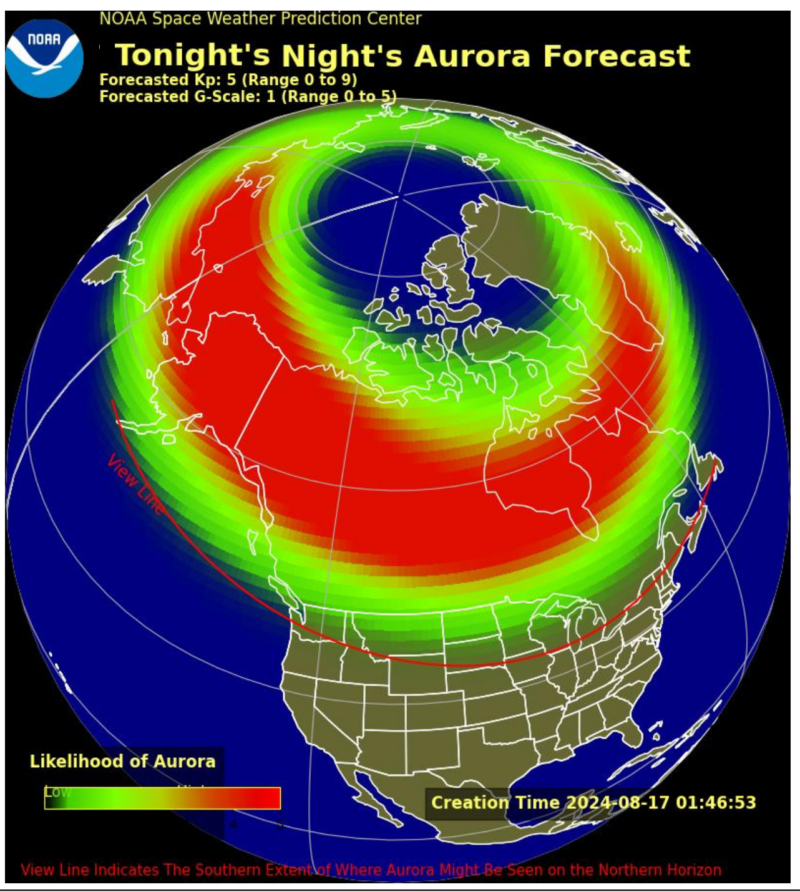 Sun news August 17: Storming from X flare due overnight tonight Today’s top story: The awaited arrival of the coronal mass ejection (CME) associated with the X1.1 flare on August 14 was expected to arrive at Earth sometime today (August 17). But the aurora forecast shows now 5 UTC on August 18, that is, midnight tonight for central North America. A G1 (minor) geomagnetic storm is anticipated with the arrival of this blob of solar material and magnetic fields. So auroras could be on the way … Meanwhile, on the sun, a third new large coronal hole is forming on the northeast. That means three sources, not two, of fast solar wind from the sun, might also provide conditions for auroral displays. Auroras, come! Last 24 hours: Sun activity was moderate during the past day (11 UTC yesterday to 11 UTC today), thanks to two M flares. Overall, the sun produced 18 flares, the two Ms plus 16 Cs. An M1.3 flare came from AR3774 at 13:24 UTC on August 16. An R1 (minor) radio blackout affected an area over the Atlantic Ocean off the west coast in Africa. The second M of the period, the largest, was an M1.6 from AR3784 at 10:33 UTC on August 17. It provoked an R1 (minor) radio blackout affecting an area over Chad in Africa. Lead flare producer this time was active region AR3790, which produced eight C flares. So the sun in the past day produced mostly faint C flares. But we also saw jets and exploding filaments on the solar disk, hurling ejecta into space. And we saw long-lasting, dancing prominences on the sun’s periphery. The sun’s east limb (edge), in particular, continued producing gorgeous arched prominences, promising action to come. And the southwest horizon, the side now rotating out of view, had some beautiful prominences, too. Currently, the sun bears nine numbered sunspot regions on its Earth-facing side. Among the nine labeled active regions there are a couple of newcomers on the sun’s southeast quadrant: AR3791 and AR3792. For now, the largest sungroup in extension is AR3784, now located in the sun’s northwest quadrant. It still has its beta-gamma-delta magnetic complexity, too. Next 24 hours: The chance for C flares is 99%. The chance for M flares is 70%. The chance for X flares is 20%. Next expected CME: No new earthbound coronal mass ejections (CMEs) were observed in the available coronagraph imagery. Current geomagnetic activity: Earth’s magnetic field is quiet at the time of this writing (11 UTC on August 17), and it seems it will remain quiet through this evening. But the coronal mass ejection (CME) associated with the X1.1 is expected overnight toight, according to clocks in North America. A G1 (minor) geomagnetic storm is predicted for early tomorrow August 18. Clear skies, aurora chasers! |
|
|
|
|
Originally Posted By Stonia: Does it actually look like that to the naked eye anywhere? https://www.ar15.com/media/mediaFiles/203509/1000009113_jpg-3292589.JPG https://www.ar15.com/media/mediaFiles/203509/1000009111_jpg-3292592.JPG View Quote I've seen them like that or more in Alaska. It was crazy. It reminded me of something from the original "Fantasia" movie. |
|
|
"Freedom is a messy business." - LaRue_Tactical
I am a sack of blood, held together by un-tanned leather. . . |
|
https://spaceweather.com/
STRONG GEOMAGNETIC STORM: A CME hit Earth's magnetic field on Aug. 17th (~1400 UT), sparking a brief but strong (G3) geomagnetic storm. The timing was bad for both European and North American sky watchers. Daylight washed out what must have been a widespread aurora display. This CME was hurled toward Earth 3 days ago by an X1-class solar flare from sunspot AR3784. CME impact alerts: SMS Text |
|
|
|
|
https://earthsky.org/sun/sun-news-activity-solar-flare-cme-aurora-updates/
 Sun news for August 17-18, 2024. The Hp30 Index is similar to the Kp index. Both indicate the power of geomagnetic storms. This chart shows the Hp30 Index, which has a higher time resolution of 30 minutes and does not max out at level 9 like Kp. It is open-ended, allowing for better distinguishing the sizes of the largest geomagnetic storms. Image via GFZ Potsdam. Sun news August 18: Sun-stuff strikes Earth, sparks auroras Today’s top story: Happy Sun Day! The coronal mass ejection (CME) spawned in the August 14 X1.1 flare ended up arriving around 13 UTC on August 17. Ah nature! Sometimes so unpredictable. The impact on Earth’s magnetic environment, the magnetosphere, sparked geomagnetic storms that also exceeded expections. They briefly reached G3 (strong) levels around 17:46 UTC (midday in central North America, early evening in Europe). So the timing of this strike was unfortunate for most of Europe and the Americas, due to the pesky interference of sunlight. Parts of Russia were graced with auroral activity, though. Last 24 hours: Meanwhile, the sun is blasting away. Sun activity has been moderate during the past day (11 UTC yesterday to 11 UTC today), thanks to six M flares. Overall, the sun produced 13 flares, the four Ms and nine Cs. The largest event of the period was an M2.4 from AR3784. It produced an R1 (minor) radio blackout over the western Pacific Ocean. AR3784 produced the most flares, three Ms and two Cs. The list of M flares is: • M1.1 at 11:44 UTC on August 17 from AR3785. R1 (minor) radio blackout over Africa. • M1.1 at 21:52 UTC on August 17 from AR3790. R1 (minor) radio blackout over the Pacific Ocean. • M1.4 at 22:06 UTC on August 17 from AR3790. R1 (minor) radio blackout over the Pacific Ocean. • M2.4 at 02:04 UTC on August 18 from AR3784. R1 (minor) radio blackout over the western Pacific Ocean. The largest. • M1.1 at 04:16 UTC on August 18 from AR3784. R1 (minor) radio blackout over Southeast Asia. • M1.3 at 07:30 UTC on August 18 from AR3784. R1 (minor) radio blackout over the Arabian Sea. AR3784 region remains the largest and most magnetically complex regon on the sun; it still has a beta-gamma-delta magnetic complexity, indicating a possibility for more strong flaring. AR3790 is a slightly calmer beta-gamma region, and the remaining sunspot regions are even simpler, either alpha or beta. In addition to the flaring, we saw some dynamic eruptions just over the northwest and western limbs. The sun has 10 active regions on its Earth-facing side today. Next 24 hours: The chance for C flares is 99%. The chance for M flares is 70%. The chance for X flares is 20%. Next expected CME: No new Earth-directed coronal mass ejections (CMEs) were observed in the available coronagraph imagery. Current geomagnetic activity: Earth’s magnetic field is quiet at the time of this writing (11 UTC on August 18). Active levels and G1 (minor) storm periods are expected early today (August 18) due to the waning influence of the X1.1 associated CME that arrived mid-day yesterday. Mostly unsettled conditions are expected on August 19 as solar wind transitions to ambient levels. Quiet conditions are expected on August 20. |
|
|
|
|
https://spaceweather.com/
A SUNSPOT OF INTEREST: New sunspot AR3790 is growing rapidly and merits watching as a potential source of strong flares in the days ahead. Already it has a 'beta-gamma' magnetic field that harbors energy for M-class solar flares. Further development could lead to X-class eruptions. Solar flare alerts: SMS Text AFTERGLOW OF A CME: A CME hit Earth's magnetic field on Aug. 17th, sparking a brief but strong (G3) geomagnetic storm. The timing was bad for sky watchers in Europe and North America, where daylight washed out a widespread aurora display. The fading afterglow, however, was visible after nightfall from Poland: 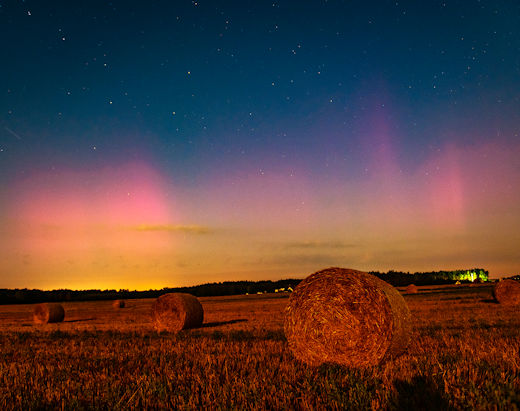 "This is the third night with aurora this week!" says photographer Marek Nikodem. "This is at latitude +53N." Frequent mid-latitude auroras are a sign that Solar Maximum has arrived. A severe (G4) storm on August 11-12 sent auroras rippling across North America as far south as Mississippi and Texas. Because Solar Max typically lasts for 2 to 3 years, many more displays can be expected between now and 2026. Aurora alerts: SMS Text |
|
|
|
 Win a FREE Membership!
Win a FREE Membership!
Sign up for the ARFCOM weekly newsletter and be entered to win a free ARFCOM membership. One new winner* is announced every week!
You will receive an email every Friday morning featuring the latest chatter from the hottest topics, breaking news surrounding legislation, as well as exclusive deals only available to ARFCOM email subscribers.
AR15.COM is the world's largest firearm community and is a gathering place for firearm enthusiasts of all types.
From hunters and military members, to competition shooters and general firearm enthusiasts, we welcome anyone who values and respects the way of the firearm.
Subscribe to our monthly Newsletter to receive firearm news, product discounts from your favorite Industry Partners, and more.
Copyright © 1996-2024 AR15.COM LLC. All Rights Reserved.
Any use of this content without express written consent is prohibited.
AR15.Com reserves the right to overwrite or replace any affiliate, commercial, or monetizable links, posted by users, with our own.

